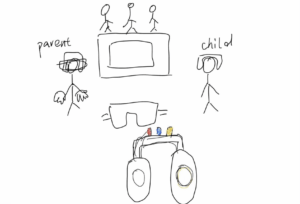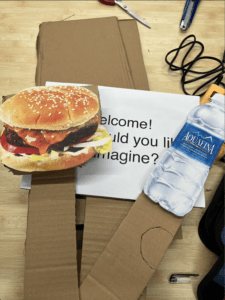Group Research Project: TV
Background & Context
Our group decided to create an interactive artifact that belongs to the universe of “The Veldt”. Following the death of the kids’ parents, they decided to get a “TV” that could provide for their needs since no adult figure could do that for them anymore. The proposed artifact works by wearing a pair of headphones that could read the thoughts of its wearer. The user would then think about the object they want and signals from the headphones would be transmitted to the antennae of the TV which would then produce the object they want. They could get these objects out of the TV by rotating a button on the side of the TV and it could also be turned on and off through the green and red buttons on the side.

Building Process
The very base of our thought process in creating this project was an image of a cardboard TV we found online since we figured that it would be easy to create with the already boxed-shaped cardboard and it is a very flexible concept to start with.

Thinking of what the TV would actually contain was a struggle for us since we wanted to make something that was interactive and original, but also feasible to do in such a short amount of time. From there, we played with the concept of making a headpiece with the TV to get the feeling of being connected with it and finally, we thought of a TV that could produce real objects instead of just showing 2D images. We chose to call it a TV rather than something new and different (like a 3D printer) since we wanted our artifact to still have this factor of familiarity with its users, especially with the antennae since it instantly reminds people of a TV. We also thought it would be a good idea to still keep some “retro” features on something that is supposed to be technologically advanced which is why we stuck with this form.

Above is a sketch of one of our initial ideas in which the actions of those wearing the helments would be mirrored by the three people at the back who would be in the TV. We ended up scrapping the idea since we thought that it was too similar to virtual reality video games.
I would consider our team to be very efficient in creating the artifact as all of us automatically did whatever we thought was necessary to improve our project. What I mostly did was prepping, cutting, and gluing the piece of cardboard that acted as the TV. I also helped polish the artifacts by sticking bond paper in the background and covering some of its features with electrical tape (like the headphones and antennae) for a neater look.
Presentation
For our presentation, we demonstrated how the artifact generates objects with the use of printed images stuck to cardboard pieces to make them more 3-dimensional.

The “generating objects” mechanism of the TV was shown by inserting the cardboard images through a slit at the bottom of the TV while the user is rotating the button at the side. One student was assigned to hold the TV while another member was assigned to put the objects through the bottom of the TV. Three students acted as the users of the machine, which I was one of. I acted cold and with the help of the machine, I was supposedly able to generate a jacket to keep me warm.
Something I do think we could have improved on in our performance was emphasizing the function of the headphones since we were asked about that after our performance. Maybe if after putting the headphones on we stopped for a second and said “I think I want a _______” the function of the device could have been clearer for the audience. Nevertheless, I think we effectively demonstrated how the TV generates what the user wants.
Evaluation of Other Team
The performance that stood out to me the most was the Magic Mirror that was part of the story “The Ones Who Walk Away from Omelas”. This is because out of all the teams, they were the only ones that thought of creating a more symbolic artifact rather than a practical one. In the mirror they created, instead of looking at your own reflection when looking into it, you would see another person mimicking your movements at the back. This person symbolizes the boy in the story who must suffer for everyone else’s happiness. Like the boy, the person behind the mirror also suffers since they’re just stuck there mimicking others for eternity. Their performance was able to show this effectively since they made use of actions that would make it clear that one was mirroring the other such as applying lipstick and even traveling around the mirror to show how the other person just follows the user. Their acting was very convincing as well especially when the person behind the mirror expresses their sadness for being stuck in that life and when showing the second user’s horror when he realizes that another person was copying him behind the mirror.




Hi, this is a comment.
To get started with moderating, editing, and deleting comments, please visit the Comments screen in the dashboard.
Commenter avatars come from Gravatar.